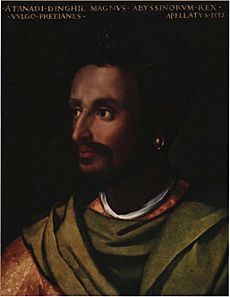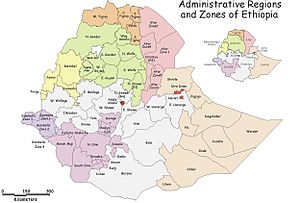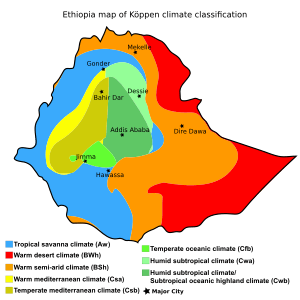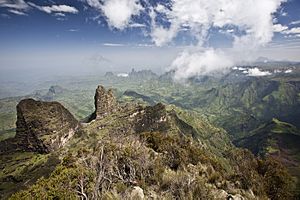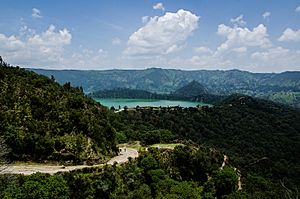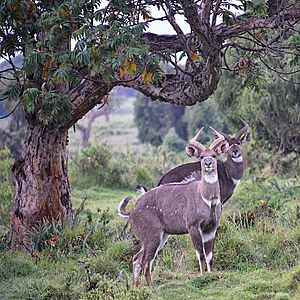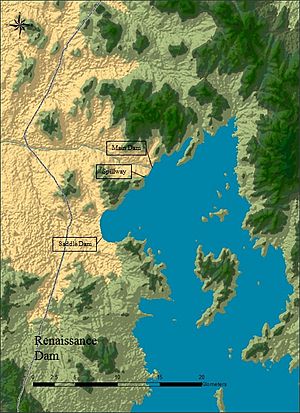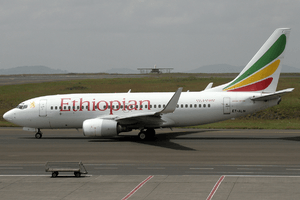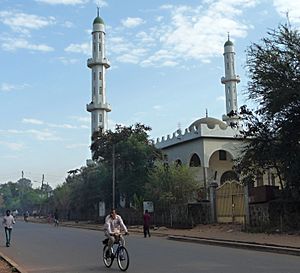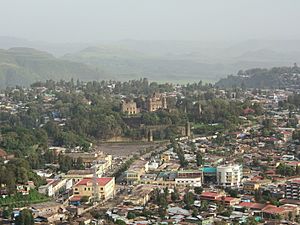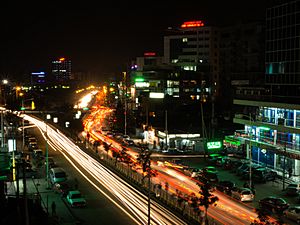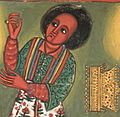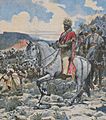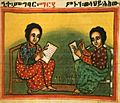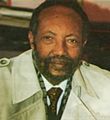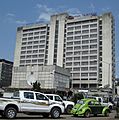Ethiopia facts for kids
Quick facts for kids
Federal Democratic Republic of Ethiopia
የኢትዮጵያ ፌዴራላዊ
ዲሞክራሲያዊ ሪፐብሊክ ye-Ītyōṗṗyā Fēdēralāwī Dīmōkrāsīyāwī Rīpeblīk |
|
|---|---|
|
|
|
|
Anthem: "March Forward, Dear Mother Ethiopia"
|
|
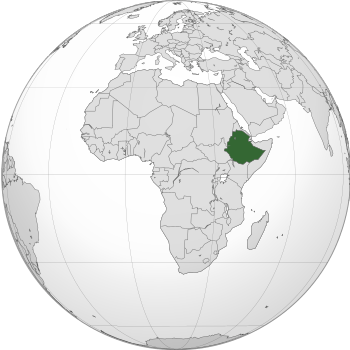 |
|
| Capital and largest city
|
Addis Ababa |
| Official languages | Amharic |
| Recognised regional languages | Other languages official amongst the different ethnicities and their respective regions. |
| Ethnic groups |
|
| Demonym(s) | Ethiopian |
| Government | Federal parliamentary republic1 |
|
• President
|
Mulatu Teshome |
| Hailemariam Desalegn | |
| Establishment | |
| 980 BC | |
| 1137 | |
|
• Current constitution
|
1991 |
| Area | |
|
• Total
|
1,104,300 km2 (426,400 sq mi) (27th) |
|
• Water (%)
|
0.7 |
| Population | |
|
• 2011 estimate
|
82,101,998 (14th) |
|
• 2007 census
|
73,918,505 |
|
• Density
|
74/km2 (191.7/sq mi) (123rd) |
| GDP (PPP) | 2011 estimate |
|
• Total
|
$94.598 billion |
|
• Per capita
|
$1,089 |
| GDP (nominal) | 2010 estimate |
|
• Total
|
$29.717 billion |
|
• Per capita
|
$350 |
| Gini (1999–00) | 30 medium |
| HDI (2010) | low · 157th |
| Currency | Birr (ETB) |
| Time zone | UTC+3 (EAT) |
|
• Summer (DST)
|
UTC+3 (not observed) |
| Driving side | right |
| Calling code | 251 |
| ISO 3166 code | ET |
| Internet TLD | .et |
|
|
Ethiopia is a country in the Horn of Africa. It has one of the most well known histories as a country in Africa and the world. Unlike other African countries, Ethiopia stayed together during the Scramble for Africa, except for 5 years when it was ruled by Italians. Ethiopia used to be called Abyssinia. The word "Ethiopia" is from the Greek word Αἰθιοπία meaning sun light burned face. BNP per capita 1370 $ (IMF) (2008).
Contents
History
The Kingdom of Aksum, the first known kingdom of great power to rise in Ethiopia, rose during the first century AD. The Persian religious figure Mani listed Axum with Rome, Persia, and China as one of the four great powers of his time. It was in the early 4th century that a Syro-Greek castaway, Frumentius, was taken to the court and over time changed King Ezana to Christianity, making Christianity Ethiopia's religion. For this, he received the title "Abba Selama". At different times, including a time in the 6th century, Axum ruled most of modern-day Yemen just across the Red Sea.
The line of rulers from the Axumite kings was broken a few times: first by the Jewish Queen Gudit around 950, then by the Zagwe dynasty. Around 1270, the Solomonid dynasty came to control Ethiopia, claiming that they were related to the kings of Axum. They called themselves Neguse Negest ("King of Kings," or Emperor), basing their claims on their direct relation to Solomon and the queen of Sheba.
During the rule of Emperor Lebna Dengel, Ethiopia made its first good contact with a European country, Portugal. This was a good development. When the Empire was attacked by Somali General and Imam, Ahmad ibn Ibrihim al-Ghazi, Portugal responded to Lebna Dengel's request for help with an army of 400 men, which helped his son Gelawdewos beat al-Ghazi and remake his rule. However, Jesuit missionaries over time offended the Orthodox faith of the local Ethiopians, and in the mid-17th century Emperor Fasilidos got rid of these missionaries. At the same time, the Oromo people began to question the Ethiopian Christian authorities in the Abyssinian territories, and wanted to keep their own religion.
All of this led to Ethiopia's isolation during the 1700s. The Emperors became figureheads, controlled by warlords like Ras Mikael Sehul of Tigray. But Amharic is the national language of Ethiopia. Ethiopian isolationism ended following a British mission that made friendship between the two nations; however, it was not until the reign of Tewodros II that Ethiopia began to take part in world matters once again.
Regions, zones, and districts
Before 1996, Ethiopia was divided into 13 provinces. Ethiopia now has ethnically based regional countries, zones, districts, and neighborhoods.
There are nine regions, sixty-eight zones and two chartered cities. Ethiopia is further divided into 550 woredas and several special woredas.
The nine regions and two chartered cities (in italics) are:
Geography
At 1,126,829 square kilometres (435,071 sq mi), Ethiopia is the world's 27th-largest country, comparable in size to Bolivia. It lies between the 3rd parallel north and the 15th parallel north and longitudes 33rd meridian east and 48th meridian east.
The major portion of Ethiopia lies on the Horn of Africa, which is the easternmost part of the African landmass. Bordering Ethiopia are Sudan and South Sudan to the west, Djibouti and Eritrea to the north, Somalia to the east and Kenya to the south. Within Ethiopia is a vast highland complex of mountains and dissected plateaus divided by the Great Rift Valley, which runs generally southwest to northeast and is surrounded by lowlands, steppes, or semi-desert. The great diversity of terrain determines wide variations in climate, soils, natural vegetation, and settlement patterns.
Ethiopia is an ecologically diverse country, ranging from the deserts along the eastern border to the tropical forests in the south to extensive Afromontane in the northern and southwestern parts. Lake Tana in the north is the source of the Blue Nile. It also has a large number of endemic species, notably the gelada, the walia ibex and the Ethiopian wolf ("Simien fox"). The wide range of altitude has given the country a variety of ecologically distinct areas, and this has helped to encourage the evolution of endemic species in ecological isolation.
Climate
The predominant climate type is tropical monsoon, with wide topographic-induced variation. The Ethiopian Highlands cover most of the country and have a climate which is generally considerably cooler than other regions at similar proximity to the Equator. Most of the country's major cities are located at elevations of around 2,000–2,500 m (6,562–8,202 ft) above sea level, including historic capitals such as Gondar and Axum.
The modern capital, Addis Ababa, is situated on the foothills of Mount Entoto at an elevation of around 2,400 metres (7,900 ft). It experiences a mild climate year round. With temperatures fairly uniform year round, the seasons in Addis Ababa are largely defined by rainfall: a dry season from October to February, a light rainy season from March to May, and a heavy rainy season from June to September. The average annual rainfall is approximately 1,200 millimetres (47 in).
There are on average 7 hours of sunshine per day. The dry season is the sunniest time of the year, though even at the height of the rainy season in July and August there are still usually several hours per day of bright sunshine. The average annual temperature in Addis Ababa is 16 °C (60.8 °F), with daily maximum temperatures averaging 20–25 °C (68.0–77.0 °F) throughout the year, and overnight lows averaging 5–10 °C (41.0–50.0 °F).
Most major cities and tourist sites in Ethiopia lie at a similar elevation to Addis Ababa and have a comparable climate. In less elevated regions, particularly the lower lying Ethiopian xeric grasslands and shrublands in the east of the country, the climate can be significantly hotter and drier. Dallol, in the Danakil Depression in this eastern zone, has the world's highest average annual temperature of 34 °C (93.2 °F).
Environment
Wildlife
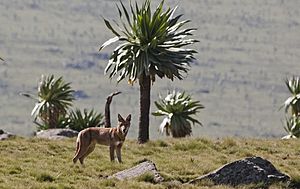
Ethiopia has 31 endemic species of mammals. The African wild dog prehistorically had widespread distribution in the territory. However, with last sightings at Finicha'a, this canid is thought to be potentially locally extinct. The Ethiopian wolf is perhaps the most researched of all the endangered species within Ethiopia.
Ethiopia is a global center of avian diversity. To date more than 856 bird species have been recorded in Ethiopia, twenty of which are endemic to the country. Sixteen species are endangered or critically endangered. A large number of these birds feed on butterflies, like the Bicyclus anynana.
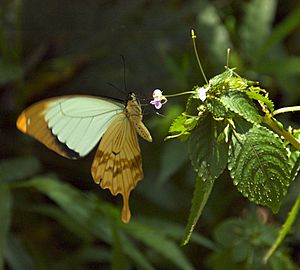
Historically, throughout the African continent, wildlife populations have been rapidly declining due to logging, civil wars, pollution, poaching, and other human factors. A 17-year-long civil war, along with severe drought, negatively impacted Ethiopia's environmental conditions, leading to even greater habitat degradation. Habitat destruction is a factor that leads to endangerment. When changes to a habitat occur rapidly, animals do not have time to adjust. Human impact threatens many species, with greater threats expected as a result of climate change induced by greenhouse gases. With carbon dioxide emissions in 2010 of 6,494,000 tonnes, Ethiopia contributes just 0.02% to the annual human-caused release of greenhouse gases.
Ethiopia has a large number of species listed as critically endangered, endangered, and vulnerable to global extinction. The threatened species in Ethiopia can be broken down into three categories (based on IUCN ratings): critically endangered, endangered, and vulnerable.
| Critically endangered mammals | Endangered mammals | Vulnerable mammals | ||
|---|---|---|---|---|
| Cushioned gerbil | Grévy's zebra | African elephant | Large-eared free-tailed bat | Red-fronted gazelle |
| Black rhinoceros | Mountain nyala | Ammodile | Lesser horseshoe bat | Rupp's mouse |
| Ethiopian wolf | Nubian ibex | Bailey's shrew | Lion | Scott's mouse-eared bat |
| Guramba shrew | African wild dog | Bale shrew | Lucina's shrew | Soemmerring's gazelle |
| Harenna shrew | Beira antelope | Morris's bat | Speke's gazelle | |
| MacMillan's shrew | Cheetah | Mouse-tailed bat | Spotted-necked otter | |
| Walia ibex | Dibatag | Natal free-tailed bat | Ethiopian striped mouse | |
| Dorcas gazelle | Nikolaus's mouse | |||
| Glass's shrew | Patrizi's trident leaf-nosed bat | |||
Deforestation
Ethiopia is one of the eight fundamental and independent centers of origin for cultivated plants in the world. However, deforestation is a major concern for Ethiopia as studies suggest loss of forest contributes to soil erosion, loss of nutrients in the soil, loss of animal habitats, and reduction in biodiversity. At the beginning of the 20th century, around 420,000 km2 (or 35%) of Ethiopia's land was covered by trees, but recent research indicates that forest cover is now approximately 11.9% of the area.
Ethiopia loses an estimated 1,410 km2 of natural forests each year. Between 1990 and 2005 the country lost approximately 21,000 km2 of forests. Current government programs to control deforestation consist of education, promoting reforestation programs, and providing raw materials which are alternatives to timber. In rural areas the government also provides non-timber fuel sources and access to non-forested land to promote agriculture without destroying forest habitat.
Organizations such as SOS and Farm Africa are working with the federal government and local governments to create a system of forest management. Working with a grant of approximately 2.3 million Euros, the Ethiopian government recently began training people on reducing erosion and using proper irrigation techniques that do not contribute to deforestation. This project is assisting more than 80 communities.
Economy
According to the IMF, Ethiopia was one of the fastest growing economies in the world, registering over 10% economic growth from 2004 through 2009. It was the fastest-growing non-oil-dependent African economy in the years 2007 and 2008. In 2015, the World Bank highlighted that Ethiopia had witnessed rapid economic growth with real domestic product (GDP) growth averaging 10.9% between 2004 and 2014.
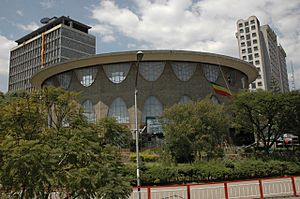
In spite of fast growth in recent years, GDP per capita is one of the lowest in the world, and the economy faces a number of serious structural problems. However, with a focused investment in public infrastructure and industrial parks, Ethiopia's economy is addressing its structural problems to become a hub for light manufacturing in Africa.
The Ethiopian constitution defines the right to own land as belonging only to "the state and the people", but citizens may lease land (up to 99 years), and are unable to mortgage or sell. Renting of land for a maximum of twenty years is allowed and this is expected to ensure that land goes to the most productive user.
Energy and hydropower
Ethiopia has 14 major rivers, which flow from its highlands, including the Nile. The country has the largest water reserves in Africa. As of 2012, hydroelectric plants represented around 88.2% of the total installed electricity capacity. The remaining electrical power was generated from fossil fuels (8.3%) and other renewable sources (3.6%). The electrification rate for the total population in 2013 was 24%, with 85% coverage in urban areas and 10% coverage in rural areas. As of 2014, total electricity production was 9.5 billion kWh and consumption was 6.7 billion kWh. There were 1.1 billion kWh in electricity exports, 0 kWh in electricity imports, and 2.4 million kW of installed generating capacity.
Ethiopia delivers roughly 81% of water volume to the Nile through the river basins of the Blue Nile, Sobat River and Atbara. In 1959, Egypt and Sudan signed a bilateral treaty, the 1959 Nile Waters Agreement, which gave both countries exclusive maritime rights over the Nile waters. Ever since, Egypt under international law vetoed almost all projects in Ethiopia that sought to utilize the local Nile tributaries. This had the effect of discouraging external financing of hydropower and irrigation projects in western Ethiopia, thereby impeding water resource-based economic development projects. However, Ethiopia is in the process of constructing a large 6,450 MW hydroelectric dam on the Blue Nile river. When completed, this Grand Ethiopian Renaissance Dam is slated to be the largest hydroelectric power station on the continent. The Gibe III hydroelectric project already generates an estimated 1,870-MW.
Agriculture
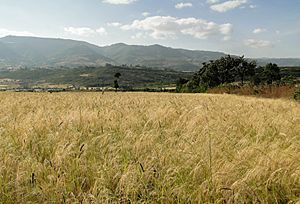
Agriculture constitutes around 85% of the labour force. However, the service sector represents the largest portion of the GDP. Many other economic activities depend on agriculture, including marketing, processing, and export of agricultural products. Production is overwhelmingly by small-scale farmers and enterprises, and a large part of commodity exports are provided by the small agricultural cash-crop sector. Principal crops include coffee, legumes, oilseeds, cereals, potatoes, sugarcane, and vegetables.
Exports are almost entirely agricultural commodities (with the exception of Gold exports), and coffee is the largest foreign exchange earner. Ethiopia is Africa's second biggest maize producer. According to UN estimations the per capita GDP of Ethiopia has reached $357 as of 2011[update]. The same report indicated that the life expectancy had improved substantially in recent years. The life expectancy of men is reported to be 56 years and for women 60 years.
Exports
Exports from Ethiopia in the 2009/2010 financial year totaled 1.4 billion USD. The country produces more coffee than any other nation on the continent.
Ethiopia also has the 5th largest inventory of cattle. Other main export commodities are khat, gold, leather products, and oilseeds. Recent development of the floriculture sector means Ethiopia is poised to become one of the top flower and plant exporters in the world.
Cross-border trade by pastoralists is often informal and beyond state control and regulation. In East Africa, over 95% of cross-border trade is through unofficial channels. The unofficial trade of live cattle, camels, sheep, and goats from Ethiopia sold to Somalia, Djibouti, and Kenya generates an estimated total value of between 250 and 300 million USD annually (100 times more than the official figure).
This trade helps lower food prices, increase food security, relieve border tensions, and promote regional integration. However, the unregulated and undocumented nature of this trade runs risks, such as allowing disease to spread more easily across national borders. Furthermore, the government of Ethiopia is purportedly unhappy with lost tax revenue and foreign exchange revenues. Recent initiatives have sought to document and regulate this trade.
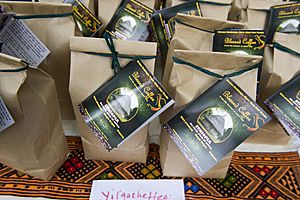
With the private sector growing slowly, designer leather products like bags are becoming a big export business, with Taytu becoming the first luxury designer label in the country. Additional small-scale export products include cereals, pulses, cotton, sugarcane, potatoes, and hides. With the construction of various new dams and growing hydroelectric power projects around the country, Ethiopia also plans to export electric power to its neighbors.
Coffee remains its most important export product, and with new trademark deals around the world (including recent deals with Starbucks) the country plans to increase its revenue from coffee. Most regard Ethiopia's large water resources and potential as its "white oil" and its coffee resources as "black gold".
The country also has large mineral resources and oil potential in some of the less inhabited regions. Political instability in those regions, however, has inhibited development. Ethiopian geologists were implicated in a major gold swindle in 2008. Four chemists and geologists from the Ethiopian Geological Survey were arrested in connection with a fake gold scandal, following complaints from buyers in South Africa. Gold bars from the National Bank of Ethiopia were found by police to be gilded metal, costing the state around 17 million USD, according to the Science and Development Network website.
In 2011, the Grand Ethiopian Renaissance Dam project was commenced. When completed, it will provide surplus energy in Ethiopia which will be available for export to neighboring countries.
Transportation
Ethiopia has 926 km of electrified 1,435 mm (4 ft 8 1⁄2 in) standard gauge railways, 656 km for the Addis Ababa – Djibouti Railway between Addis Ababa and the Port of Djibouti (via Awash) and 270 km for the Awash – Hara Gebeya Railway between Addis Ababa and the twin cities of Dessie/Kombolcha (also via Awash). Both railways are either in trial service or still under construction as of August 2017. Once commissioned and fully operational in 2018/2019, both railways will allow passenger transport with a designated speed of 120 km/hour and freight transport with a speed of ~80 km/hour. Expected travel time from Addis Ababa to Djibouti City for passengers would be less than twelve hours and travel time from Addis Ababa to Dessie/Kombolcha would be around six hours.
Beyond the first 270 km of the Awash – Hara Gebeya Railway, a second construction phase over 120 km foresees the extension of this railway from Dessie/Kombolcha to Hara Gebeya/Woldiya. It is not clear, when this section will be built and opened. A third, northern 216 km long railway is also under construction between Mek'ele and Woldiya, but it is also not clear, when this railway will be commissioned and opened. All railways are part of a future railway network of more than 5,000 km of railways, the National Railway Network of Ethiopia.
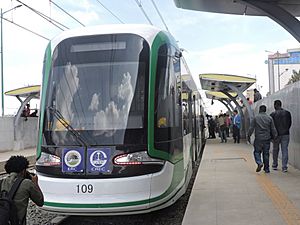
As the first part of a ten-year Road Sector Development Program, between 1997 and 2002 the Ethiopian government began a sustained effort to improve its infrastructure of roads. As a result, as of 2015[update] Ethiopia has a total (Federal and Regional) of 100,000 km of roads, both paved and gravel.
Ethiopia had 58 airports as of 2012[update], and 61 as of 2016. Among these, the Bole International Airport in Addis Ababa and the Aba Tenna Dejazmach Yilma International Airport in Dire Dawa accommodate international flights. Ethiopian Airlines is the country's flag carrier, and is wholly owned by the Government of Ethiopia. From its hub at the Bole International Airport, the airline serves a network of 62 international destinations and 16 domestic ones. It is also one of the fastest-growing carriers in the industry and continent.
Demographics
| Ethnic groups in Ethiopia | ||||
|---|---|---|---|---|
| Ethnic group | Population | |||
| Oromo | 25.4 (34.4%) | |||
| Amhara | 19.9 (27.0%) | |||
| Somali | 4.59 (6.22%) | |||
| Tigrayans | 4.49 (6.08%) | |||
| Sidama | 2.95 (4.00%) | |||
| Gurage | 1.86 (2.52%) | |||
| Welayta | 1.68 (2.27%) | |||
| Afar | 1.28 (1.73%) | |||
| Hadiya | 1.27 (1.72%) | |||
| Gamo | 1.10 (1.49%) | |||
| others | 9.30 (12.6%) | |||
| Population in millions according to 2007 Census | ||||
Ethiopia's population has grown from 33.5 million in 1983 to 87.9 million in 2014. The population was only about 9 million in the 19th century. The 2007 Population and Housing Census results show that the population of Ethiopia grew at an average annual rate of 2.6% between 1994 and 2007, down from 2.8% during the period 1983–1994. Currently, the population growth rate is among the top ten countries in the world. The population is forecast to grow to over 210 million by 2060, which would be an increase from 2011 estimates by a factor of about 2.5.
| Population in Ethiopia | |||
|---|---|---|---|
| Year | Million | Difference | |
| 1950 | 18.4 | – | |
| 1960 | 22.5 | 4.1 | |
| 1970 | 29.0 | 6.5 | |
| 1980 | 35.4 | 6.4 | |
| 1990 | 48.3 | 12.9 | |
| 2000 | 65.6 | 17.3 | |
| 2010 | 82.9 | 17.3 | |
| 2013 | 93.8 | >10.9 | |
The country's population is highly diverse, containing over 80 different ethnic groups. According to the Ethiopian national census of 2007, the Oromo are the largest ethnic group in Ethiopia, at 34.4% of the nation's population. The Amhara represent 27.0% of the country's inhabitants, while Somalis and Tigrayans represent 6.22% and 6.08% of the population, respectively. Other prominent ethnic groups are as follows: Sidama 4.00%, Gurage 2.52%, Welayta 2.27%, Afar 1.73%, Hadiya 1.72%, Gamo 1.49% and others 12.6%.
Afroasiatic-speaking communities make up the majority of the population. Among these, Semitic speakers often collectively refer to themselves as the Habesha people. The Arabic form of this term (al-Ḥabasha) is the etymological basis of "Abyssinia," the former name of Ethiopia in English and other European languages. Additionally, Nilo-Saharan-speaking ethnic minorities inhabit the southern regions of the country, particularly in areas of the Gambela Region which borders South Sudan. The largest ethnic groups among these include the Nuer and Anuak.
In 2009, Ethiopia hosted a population of refugees and asylum seekers numbering approximately 135,200. The majority of this population came from Somalia (approximately 64,300 persons), Eritrea (41,700) and Sudan (25,900). The Ethiopian government required nearly all refugees to live in refugee camps.
Languages
According to Ethnologue, there are ninety individual languages spoken in Ethiopia. Most people in the country speak Afroasiatic languages of the Cushitic or Semitic branches. The former includes Oromiffa, spoken by the Oromo, and Somali, spoken by the Somalis; the latter includes Amharic, spoken by the Amhara, and Tigrinya, spoken by the Tigrayans. Together, these four groups make up about three-quarters of Ethiopia's population. Other Afroasiatic languages with a significant number of speakers include the Cushitic Sidamo, Afar, Hadiyya and Agaw languages, as well as the Semitic Gurage languages, Harari, Silt'e, and Argobba languages. Arabic, which also belongs to the Afroasiatic family, is likewise spoken in some areas.
Additionally, Omotic languages are spoken by Omotic ethnic minority groups inhabiting the southern regions. Among these idioms are Aari, Bench, Dime, Dizin, Gamo-Gofa-Dawro, Maale, Hamer, and Wolaytta.
Languages from the Nilo-Saharan family are also spoken by ethnic minorities concentrated in the southwestern parts of the country. These languages include Nuer, Anuak, Nyangatom, Majang, Suri, Me'en, and Mursi.
English is the most widely spoken foreign language, and is the medium of instruction in secondary schools. Amharic was the language of primary school instruction, but has been replaced in many areas by regional languages such as Oromiffa, Somali or Tigrinya. While all languages enjoy equal state recognition in the 1995 Constitution of Ethiopia, Amharic is recognized as the official working language of the Federal Government. The various regions of Ethiopia and chartered cities are free to determine their own working languages. Amharic is recognised as the official working language of Amhara Region, Benishangul-Gumuz, Southern Nations, Nationalities, and Peoples' Region, Gambela Region, Addis Abeba and Dire Dawa, while Afar, Harari, Oromiffa, Somali and Tigrinya are recognized as official working languages in their respective regions.
Script
In terms of writing systems, Ethiopia's principal orthography is the Ge'ez script. Employed as an abugida for several of the country's languages, it first came into usage in the 6th and 5th centuries BC as an abjad to transcribe the Semitic Ge'ez language. Ge'ez now serves as the liturgical language of the Ethiopian Orthodox Tewahedo Church and Eritrean Orthodox Tewahedo Church. During the 1980s, the Ethiopic character set was computerized. It is today part of the Unicode standard as Ethiopic, Ethiopic Extended, Ethiopic Supplement and Ethiopic Extended-A.
Other writing systems have also been used over the years by different Ethiopian communities. The latter include Bakri Sapalo's script for Oromiffa.
Religion
Religion in Ethiopia (2007) Ethiopian Orthodoxy (43.5%) Islam (33.9%) Pentay (Protestant) (18.6%) Traditional faiths (2.6%) Catholicism (0.7%) Other (0.7%)
Ethiopia has close historical ties with all three of the world's major Abrahamic religions. In the 4th century, the region was one of the first in the world to officially adopt Christianity as the state religion. As a result of the resolutions of the Council of Chalcedon, in 451 the miaphysites, which included the vast majority of Christians in Egypt and Ethiopia, were accused of monophysitism and designated as heretics under the common name of Coptic Christianity (see Oriental Orthodoxy). While no longer distinguished as a state religion, the Ethiopian Orthodox Tewahedo Church remains the majority Christian denomination. There is also a substantial Muslim demographic, representing around a third of the population. Additionally, Ethiopia is the site of the First Hegira, a major emigration in Islamic history. A town in the Tigray Region, Negash is the oldest Muslim settlement in Africa. Until the 1980s, a substantial population of Beta Israel (Ethiopian Jews) resided in Ethiopia.
According to the 2007 National Census, Christians make up 62.8% of the country's population (43.5% Ethiopian Orthodox, 19.3% other denominations), Muslims 33.9%, practitioners of traditional faiths 2.6%, and other religions 0.6%. This is in agreement with the CIA World Factbook, which states that Christianity is the most widely practiced religion in Ethiopia. The ratio of the Christian to Muslim population has largely remained stable when compared to previous censuses conducted decades ago. Sunnis form the majority of Muslims with non-denominational Muslims being the second largest group of Muslims, and the Shia and Ahmadiyyas are a minority. Sunnis are largely Shafi'is or Salafis, and there are also many Sufi Muslims there. The large Muslim population in the northern Afar region has resulted in a Muslim separatist movement called the "Islamic State of Afaria" seeking a sharia-compliant constitution.
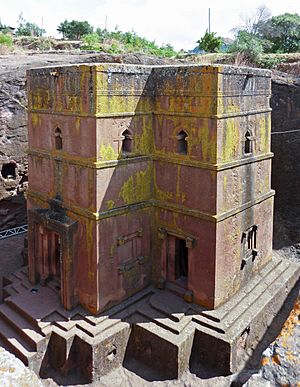
The Kingdom of Aksum was one of the first polities to officially embrace Christianity, when Frumentius of Tyre, called Fremnatos or Abba Selama ("Father of Peace") in Ethiopia, converted Emperor Ezana during the fourth century. According to the New Testament, Christianity had entered Ethiopia even earlier, when an official in the Ethiopian royal treasury was baptized by Philip the Evangelist.
The Ethiopian Orthodox Tewahedo Church is part of Oriental Orthodoxy. It is by far the largest Christian denomination, although a number of P'ent'ay (Protestant) churches have recently gained ground. Since the 18th century, a relatively small Ethiopian Catholic Church has existed in full communion with Rome, with adherents making up less than 1% of the total population.
Islam in Ethiopia dates back to the founding of the religion in 622 when a group of Muslims were counseled by Muhammad to escape persecution in Mecca. The disciples subsequently migrated to Abyssinia via modern-day Eritrea, which was at the time ruled by Ashama ibn-Abjar, a pious Christian emperor. Also, the largest single ethnic group of non-Arab Sahabah was that of the Ethiopians.
A small ancient group of Jews, the Beta Israel, live in northwestern Ethiopia, though most immigrated to Israel in the last decades of the 20th century as part of the Israeli government's relocation missions: Operation Moses and Operation Solomon.
According to the 2007 Population and Housing Census, around 1,957,944 people in Ethiopia are adherents of traditional religions. An additional 471,861 residents practice other creeds. While followers of all religions can be found in each region, they tend to be concentrated in certain parts of the country. Christians predominantly live in the northern Amhara and Tigray regions, and are largely members of the non-Chalcedonian Ethiopian Orthodox Tewahedo Church. Those belonging to P'ent'ay are centered in the Southern Nations, Nationalities, and Peoples' Region (SNNP) and Oromia. Muslims in Ethiopia predominantly adhere to Sunni Islam and generally inhabit eastern and northeastern areas; particularly the Somali, Afar, Dire Dawa and Harari regions. Practitioners of traditional religions mainly reside in the nation's far southwestern and western rural borderlands, in the SNNP, Benishangul-Gumuz and Gambela regions.
Human rights groups have regularly accused the government of arresting activists, journalists and bloggers to stamp out dissent among some religious communities. Lengthy prison terms were handed to 17 Muslim activists on 3 August 2015 ranging from seven to 22 years. They were charged with trying to create an Islamic state in the majority Christian country. All the defendants denied the charges and claimed that they were merely protesting in defence of their rights.
Urbanization
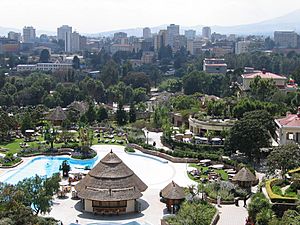
Population growth, migration, and urbanization are all straining both governments' and ecosystems' capacity to provide people with basic services. Urbanization has steadily been increasing in Ethiopia, with two periods of significantly rapid growth. First, in 1936–1941 during the Italian occupation of Mussolini's fascist regime, and from 1967 to 1975 when the populations of urban centers tripled.
In 1936, Italy annexed Ethiopia, building infrastructure to connect major cities, and a dam providing power and water. This along with the influx of Italians and laborers was the major cause of rapid growth during this period. The second period of growth was from 1967 to 1975 when rural populations migrated to urban centers seeking work and better living conditions.
This pattern slowed due to the 1975 Land Reform program instituted by the government, which provided incentives for people to stay in rural areas. As people moved from rural areas to the cities, there were fewer people to grow food for the population. The Land Reform Act was meant to increase agriculture since food production was not keeping up with population growth over the period of 1970–1983. This program proliferated the formation of peasant associations, large villages based on agriculture. The act did lead to an increase in food production, although there is debate over the cause; it may be related to weather conditions more than the reform act. Urban populations have continued to grow with an 8.1% increase from 1975 to 2000. Template:Largest cities or towns of Ethiopia
Rural and urban life
Migration to urban areas is usually motivated by the hope of better lives. In peasant associations daily life is a struggle to survive. About 16% of the population in Ethiopia are living on less than 1 dollar per day (2008). Only 65% of rural households in Ethiopia consume the World Health Organization's minimum standard of food per day (2,200 kilocalories), with 42% of children under 5 years old being underweight.
Most poor families (75%) share their sleeping quarters with livestock, and 40% of children sleep on the floor, where nighttime temperatures average 5 degrees Celsius in the cold season. The average family size is six or seven, living in a 30-square-meter mud and thatch hut, with less than two hectares of land to cultivate.
The peasant associations face a cycle of poverty. Since the landholdings are so small, farmers cannot allow the land to lie fallow, which reduces soil fertility. This land degradation reduces the production of fodder for livestock, which causes low milk yields. Since the community burns livestock manure as fuel, rather than plowing the nutrients back into the land, the crop production is reduced. The low productivity of agriculture leads to inadequate incomes for farmers, hunger, malnutrition and disease. These unhealthy farmers have difficulty working the land and the productivity drops further.
Although conditions are drastically better in cities, all of Ethiopia suffers from poverty and poor sanitation. However, poverty in Ethiopia fell from 44% to 29.6% during 2000–2011, according to the World Bank. In the capital city of Addis Ababa, 55% of the population used to live in slums. Now, however, a construction boom in both the private and public sector has led to a dramatic improvement in living standards in major cities, particularly in Addis Ababa. Notably, government-built condominium housing complexes have sprung up throughout the city, benefiting close to 600,000 individuals. Sanitation is the most pressing need in the city, with most of the population lacking access to waste treatment facilities. This contributes to the spread of illness through unhealthy water.
Despite the living conditions in the cities, the people of Addis Ababa are much better off than people living in the peasant associations owing to their educational opportunities. Unlike rural children, 69% of urban children are enrolled in primary school, and 35% of those are eligible to attend secondary school. Addis Ababa has its own university as well as many other secondary schools. The literacy rate is 82%.
Culture

Naming
Ethiopians have a different naming system to the family name-based Western system. Children add the given names of their father and paternal grandfather consecutively to their own given name. For compatibility purposes, as is done in passports, the grandfather's given name is taken as a family surname, and a person's given name and his/her father's given name form the first name.
Everyone is addressed by his/her given name. In official situations, the prefixes Ato (አቶ) is used for men; Weyzero (ወይዘሮ) for married women; and Weyzerīt (ወይዘሪት) for unmarried women.
Calendar
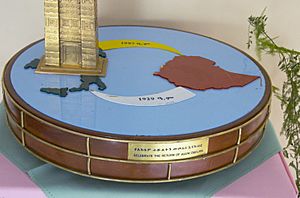
Ethiopia has several local calendars. The most widely known is the Ethiopian calendar, also known as the Ge'ez calendar. It is based on the older Alexandrian or Coptic calendar, which in turn derives from the Egyptian calendar. Like the Coptic calendar, the Ethiopian calendar has twelve months of exactly 30 days each plus five or six epagomenal days, which comprise a thirteenth month. The Ethiopian months begin on the same days as those of the Coptic calendar, but their names are in Ge'ez.
Like the Julian calendar, the sixth epagomenal day—which in essence is a leap day—is added every four years without exception on 29 August of the Julian calendar, six months before the Julian leap day. Thus, the first day of the Ethiopian year, 1 Mäskäräm, for years between 1901 and 2099 (inclusive), is usually 11 September (Gregorian), but falls on 12 September in years before the Gregorian leap year. Also, a seven- to eight-year gap between the Ethiopian and Gregorian calendars results from an alternate calculation in determining the date of the Annunciation of Jesus.
Another prominent calendrical system was developed around 300 BC by the Oromo. A lunar-stellar calendar, this Oromo calendar relies on astronomical observations of the moon in conjunction with seven particular stars or constellations. Oromo months (stars/lunar phases) are Bittottessa (Iangulum), Camsa (Pleiades), Bufa (Aldebarran), Waxabajjii (Belletrix), Obora Gudda (Central Orion-Saiph), Obora Dikka (Sirius), Birra (full moon), Cikawa (gibbous moon), Sadasaa (quarter moon), Abrasa (large crescent), Ammaji (medium crescent), and Gurrandala (small crescent).
Time
Time in Ethiopia is counted differently from in many Western countries. The Ethiopian day is reckoned as beginning at 6 AM as opposed to 12 AM, concurrently with sunrise throughout the year. To convert between the Ethiopian clock and Western clocks, one must add (or subtract) 6 hours to the Western time. For example, 2 AM local Addis Ababa time is called "8 at night" in Ethiopia, while 8 PM is called "2 in the evening".
Cuisine
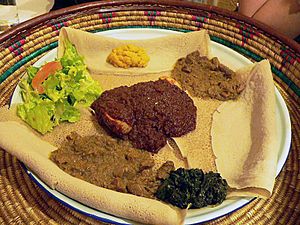
The best-known Ethiopian cuisine consists of various types of thick meat stews, known as wat in Ethiopian culture, and vegetable side dishes served atop injera, a large sourdough flatbread made of teff flour. This is not eaten with utensils, but instead one uses the injera to scoop up the entrées and side dishes. Almost universally in Ethiopia, it is common to eat from the same dish in the center of the table with a group of people. It is also a common custom to feed others in your group with your own hands—a tradition referred to as "gursha". Traditional Ethiopian cuisine employs no pork or shellfish of any kind, as they are forbidden in the Islamic, Jewish, and Ethiopian Orthodox faiths.
Chechebsa, marqa, chukko, michirra and dhanga are the most popular dishes from the Oromo. Kitfo, which originated among the Gurage, is one of the country's most popular delicacies. In addition, Doro wot is another popular food, originated from the Amhara people of northwestern Ethiopia. Tihlo (ጥሕሎ)—which is a type of dumpling—is prepared from roasted barley flour. It originated in the Tigray Region, and is now very popular in Amhara and spreading further south.
Music
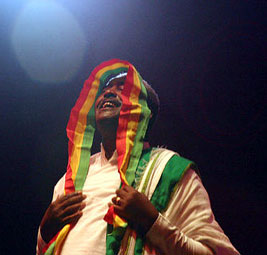
The music of Ethiopia is extremely diverse, with each of the country's 80 ethnic groups being associated with unique sounds. Ethiopian music uses a distinct modal system that is pentatonic, with characteristically long intervals between some notes. As with many other aspects of Ethiopian culture and tradition, tastes in music and lyrics are strongly linked with those in neighboring Eritrea, Somalia, Djibouti, and Sudan. Traditional singing in Ethiopia presents diverse styles of polyphony (heterophony, drone, imitation, and counterpoint). Traditionally, lyricism in Ethiopian song writing is strongly associated with views of patriotism or national pride, romance, friendship, and a most unique type of memoire known as 'Tizita'.
Sport
The main sports in Ethiopia are track and field (particularly long distance running) and football (soccer). Ethiopian athletes have won many Olympic gold medals in track and field, most of them in long distance running. Haile Gebrselassie is a world-renowned long distance runner with several world records under his belt. Kenenisa Bekele and Tirunesh Dibaba are also dominant runners, particularly in the 5,000 and 10,000 meters in which they hold the world records.
Other notable Ethiopian athletes are Abebe Bikila, Mamo Wolde, Miruts Yifter, Derartu Tulu, Meseret Defar, Almaz Ayana, Birhane Adere, Tiki Gelana, Genzebe Dibaba, Tariku Bekele, and Gelete Burka. As of 2012[update] going into 2013, the current national Ethiopian football team (Walayia Antelopes) has made itself history by qualifying for the 2012 African Cup of Nations (CAF) and more recently by reaching the last 10 African football teams in the last stage of qualification for the 2014 FIFA World Cup. Noted players include captain Adane Girma and top scorer Saladin Said.
Ethiopia has Sub-Saharan Africa's longest basketball tradition as it established a national basketball team in 1949.
Related pages
Images for kids
-
A Homo sapiens idaltu hominid skull
-
Aksumite currency of the Aksumite king called Endubis, 227–35, at the British Museum. The inscriptions in Ancient Greek read "ΑΧΩΜΙΤΩ ΒΑΣΙΛΕΥΣ" ("King of Axum") and "ΕΝΔΥΒΙΣ ΒΑΣΙΛΕΥΣ" ("King Endubis"), the Greek language was the lingua franca by that time so its use in coins simplified foreign trade.
-
Emperor Yekuno Amlak portrait allegedly from the 18th century
-
Emperor Susenyos I was the first emperor converted to Roman Catholic in 1622, stressing the populace attitude of Orthodox Tewahedo Christianity
-
Emperor Tewodros II (r. 1855 – 1868) brought an end of Zemene Mesafint
-
The conquests of Emperor Yohannes IV, Negus Menelik and general Ras Alula in 1879–1889
-
Haile Selassie at his study in Jubilee Palace (1942)
-
Ethiopian cavalry during the Second Italo-Ethiopian War in 1936
-
Ras Seyoum Mengesha, Ras Getachew Abate and Ras Kebede Gubret with Benito Mussolini on 6 February 1937 in Rome, Italy, after the Italian occupation of Ethiopia
-
Former Prime Minister of Ethiopia Hailemariam Desalegn meeting with former US Deputy Secretary of Defense Ash Carter in Addis Ababa.
-
Prime Minister Abiy Ahmed receiving the Nobel Peace Prize in Oslo in 2019
-
Orthodox priests dancing during the celebration of Timkat
-
Illustration showing two Aksumite scribes
-
Giyorgis of Segla, prolific religious author in the Late Middle Ages
-
Meskel commemorates the discovery of True Cross by Roman queen Helena in 326 AD
-
Genzebe Dibaba middle- and long-distance runner. A 1500 metres 2016 Rio Olympics silver medalist, she won a gold medal in this event and a bronze in the 5000 metres at the 2015 World Championships.
See also
 In Spanish: Etiopía para niños
In Spanish: Etiopía para niños




